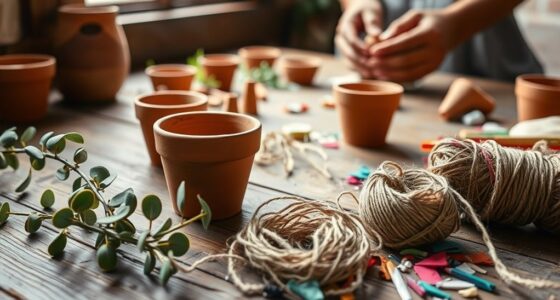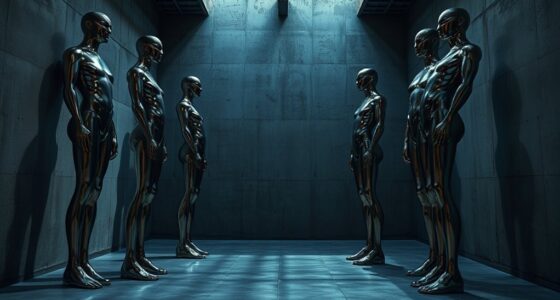AI-driven art creates exciting collaborations between you and machines, pushing the boundaries of creativity. When you work with AI, you can generate unique variations and explore new concepts that challenge traditional ideas of originality. However, this partnership raises ethical questions about ownership, transparency, and bias, which you should consider. As AI expands artistic possibilities, understanding its social and moral implications can help you navigate this innovative landscape—there’s much more to discover as you explore further.
Key Takeaways
- AI acts as a creative partner, generating novel variations and ideas to enhance human artistic expression.
- Collaboration with AI expands artistic possibilities, fostering innovation and pushing traditional aesthetic boundaries.
- Ethical considerations include transparency, ownership, and addressing bias to ensure responsible AI-driven art practices.
- Disclosing AI involvement maintains authenticity and honesty, helping audiences understand the collaborative process.
- Responsible integration of AI tools supports inclusive, ethical, and socially conscious art creation and innovation.

Artificial intelligence is transforming the world of art by enabling creators to push boundaries and explore new possibilities. When you use AI tools, you’re tapping into the power of algorithmic creativity, where machines generate or assist in producing artworks that challenge traditional notions of authorship and aesthetics. This collaboration between humans and machines opens up exciting avenues for innovation, but it also raises important questions about the ethical implications involved. As you experiment with AI in your artistic process, you might find yourself questioning who truly owns the final piece—yourself, the algorithm, or both? Understanding the ethical landscape becomes vital as AI-generated art becomes more prevalent. Concerns about originality, copyright, and the potential for AI to replicate or even plagiarize existing works are central to these discussions.
In this new era of artistic creation, algorithms aren’t just tools—they often act as creative partners, producing outputs that can surprise and inspire you. You might input a prompt, select parameters, or provide initial sketches, and the AI responds with variations or entirely new concepts. This process exemplifies algorithmic creativity, where the machine’s ability to generate original ideas enhances your own creative journey. However, as you lean more on AI, you should remain mindful of the ethical implications. Questions about transparency arise—should creators disclose how much of their work was generated or influenced by AI? Should AI-generated art be labeled as such to maintain honesty? These issues challenge the traditional understanding of artistic authenticity and demand that you consider your responsibilities as a creator.
AI as a creative partner challenges authenticity—should we disclose AI influence to ensure honesty?
Moreover, the use of AI in art prompts discussions about bias and representation. Since algorithms learn from existing datasets, they can inadvertently perpetuate stereotypes or exclude diverse perspectives. As you incorporate AI into your work, you have a responsibility to ensure that your art promotes inclusivity and fairness. The ethical implications are not just about legality but also about social impact. You might also wonder about the future of human creativity. Will AI supplement your skills or replace certain roles? While AI can handle repetitive or technical tasks, it’s up to you to decide how to integrate these tools ethically and meaningfully. Additionally, ongoing research into AI vulnerabilities and bias highlights the importance of critical engagement with these technologies to prevent unintended consequences.
Ultimately, embracing AI-driven art means balancing innovation with integrity. You’re invited to experiment freely, but with awareness of the broader cultural and moral context. By understanding algorithmic creativity and its ethical implications, you can forge a path that respects both the power of machines and the unique voice you bring to your art. This partnership has the potential to redefine what art can be—if you approach it thoughtfully and responsibly.
Frequently Asked Questions
How Do Artists Maintain Originality With Ai-Generated Art?
You maintain originality with AI-generated art by focusing on authentic expression and keeping your artistic integrity intact. You personalize the process by selecting unique prompts, curating outputs, and adding your own touches. By blending your creativity with AI tools, you guarantee your work remains distinct and true to your vision. This active engagement helps you stand out, preserving your originality while embracing innovative technology as a collaborative partner.
What Ethical Concerns Arise From Ai-Created Artworks?
You face ethical concerns around authenticity, intellectual property, and transparency. You must consider whether AI-generated art truly reflects human creativity or if it dilutes originality. You question who owns the rights to machine-created works and how to respect existing intellectual property. You need to balance innovation with responsibility, ensuring that the use of AI respects artists’ rights and maintains trust, while addressing authenticity concerns in your creative process.
Can AI Art Be Considered Truly Creative or Emotional?
You might wonder if AI art is truly creative or emotional. While machines can simulate emotion and generate impressive visuals, they lack genuine feelings and personal experience, which are key to authentic creativity. AI can mimic emotion through patterns, but it doesn’t possess machine emotion or the ability to infuse artworks with true human authenticity. So, AI art reflects technical skill more than true emotional depth or creative authenticity.
How Does AI Influence Traditional Art Markets?
AI influences traditional art markets by driving market disruption, especially through AI-driven auctions that showcase digital art and NFTs. You might find that collectors increasingly value AI-generated pieces, which challenge conventional notions of authenticity and originality. This shift can both expand and complicate the market, encouraging new investment opportunities but also raising questions about the future of traditional art valuation and the role of human creativity in a rapidly evolving landscape.
What Skills Are Needed to Collaborate Effectively With AI in Art?
To collaborate effectively with AI in art, you need machine literacy and creative adaptability. Machine literacy helps you understand AI tools and how they generate art, while creative adaptability lets you experiment and refine ideas alongside the technology. You should stay open to new processes, learn how to manipulate algorithms, and embrace iterative workflows. This combination guarantees you leverage AI’s potential, creating innovative, collaborative pieces that blend human creativity with machine capabilities.
Conclusion
As you explore AI-driven art, remember that two heads are better than one. By collaborating with machines, you unveil endless creative possibilities that push boundaries and inspire innovation. Embrace the synergy between human intuition and machine precision, knowing that the best art often emerges from such partnerships. Ultimately, it’s clear that the future of art belongs to those willing to adapt and collaborate—proving that where there’s a will, there’s a way.









